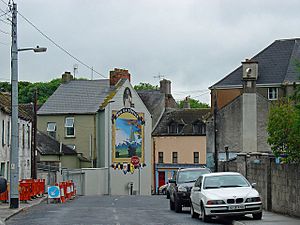Sir Standish Hartstonge, 2nd Baronet facts for kids
Sir Standish Hartstonge, 2nd Baronet (born around 1671-1673 – died 1751) was an important person in Ireland with English family roots. He owned a lot of land and was a politician. He served in the Irish House of Commons, which was like the Irish Parliament, for many years. When he was only about 18 or 19, he got married. This marriage caused a huge family argument that led to many years of legal battles.
Contents
Who Was Standish Hartstonge?
His Early Years
Standish Hartstonge was born between 1671 and 1673, most likely in Cork, Ireland. He was the only son of Francis Hartstonge and Mary Brettridge. His father, Francis, was the oldest son of Sir Standish Hartstonge, 1st Baronet. The first Sir Standish was a famous lawyer from England who worked as a judge in Ireland.
When Standish's father, Francis, died in 1688, young Standish went to live with his grandfather, the first Sir Standish, in England. In 1686, a room was set aside for Standish and his future family at Trinity College Dublin. It's not clear if he studied there, but he likely learned some law, as he later held a small legal job.
A Big Family Argument
Within two years of moving to England, young Standish had a serious disagreement with his grandfather. This started a big family argument that involved everyone in the Hartstonge family. The problem was his marriage. Around 1690, when he was still a teenager, Standish married Anne Price. She was about six years older than him.
His grandfather was very angry about this marriage. He even wrote about it in his will, which is a legal document saying who gets what after someone dies. He wrote, "my grandchild who disobliged me by his marriage; I shall only say God give him joy of it, but I shall not add to it for that cause." This means he wished Standish well but wouldn't give him more money because of the marriage.
The grandfather was upset for a few reasons. First, Standish didn't ask him before getting married. Second, Standish was very young. Third, the grandfather didn't like Anne's family because they owed a lot of money. The grandfather knew about money problems because he had married into a family that was also in debt.
The elder Sir Standish returned to Ireland around 1691. Young Standish and his family stayed in England for a while but moved to Ireland in the mid-1690s. His grandfather probably died in 1701.
Legal Battles Over Money
In his will, Standish's grandfather left most of his property to Gwynne, his teenage son from his third wife. The grandfather might have thought young Standish already had enough money from his parents, who had left him large estates in Limerick and Cork.
However, in 1702, Standish started a lawsuit against Gwynne and two of his other uncles. He wanted the will to be declared invalid. From what we know, the court decided in favor of young Gwynne. Gwynne later died young and unmarried. Another uncle, also named Standish Hartstonge, also specifically left young Standish out of his will when he died in 1704.
Standish's Public Life
Starting His Career
In 1701, Standish became a judge in the special court of County Tipperary. This job was often seen as an easy one that didn't require much work. It's not clear if he had formal legal training. His appointment showed that he was supported by James Butler, 2nd Duke of Ormond. The Duke of Ormond had the power to choose judges for this court.
The court was closed down in 1715. Standish's career didn't seem to suffer even when the Duke of Ormond lost power and had to leave the country.
Standish also helped to rebuild a memorial in a church in Bruff, Ireland. This memorial honored his great-great-grandfather, Sir Thomas Standish, and included important information about the family.
Becoming a Politician
Even though they had argued about the family inheritance, Standish generally got along well with his most important relative, his uncle John Hartstonge, who was a Bishop. With his uncle's help, Standish became a member of the Irish House of Commons.
He served as a Member of Parliament (MP) for different areas: first for Kilmallock, then Ratoath, and finally St. Canice. He died in 1751, when he was almost eighty years old.
His Family Legacy
Standish Hartstonge and Anne Price had at least five children. Two of them died when they were very young. Their surviving children were Price, John, and Catherine.
His older son, Price Hartstonge, also became a Member of Parliament, just like his father. However, Price died before his father in 1743. Because of this, the family title of Baronet passed to Price's only son, Sir Henry Hartstonge, 3rd Baronet.


